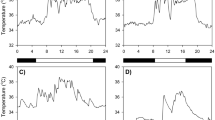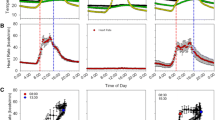Abstract
During entrance into hibernation in golden-mantled ground squirrels (Callospermophilus lateralis), ventilation decreases as metabolic rate and body temperature fall. Two patterns of respiration occur during deep hibernation. At 7 °C body temperature (T b ), a breathing pattern characterized by episodes of multiple breaths (20.6 ± 1.9 breaths/episode) separated by long apneas or nonventilatory periods (T nvp ) (mean = 11.1 ± 1.2 min) occurs, while at 4 °C T b , a pattern in which breaths are evenly distributed and separated by a relatively short T nvp (0.5 ± 0.05 min) occurs. Squirrels exhibiting each pattern have similar metabolic rates and levels of total ventilation (0.2 and 0.23 ml O2/hr/kg and 0.11 and 0.16 ml air/min/kg, respectively). Squirrels at 7 °C T b exhibit a significant hypoxic ventilatory response, while squirrels at 4 °C T b do not respond to hypoxia at any level of O2 tested. Squirrels at both temperatures exhibit a significant hypercapnic ventilatory response, but the response is significantly reduced in the 4 °C T b squirrels. Carotid body denervation has little effect on the breathing patterns or on the hypercapnic ventilatory responses. It does reduce the magnitude and threshold for the hypoxic ventilatory response. Taken together the data suggest that (1) the fundamental rhythm generator remains functional at low temperatures; (2) the hypercapnic ventilatory response arises from central chemoreceptors that remain functional at very low temperatures; (3) the hypoxic ventilatory response arises from both carotid body and aortic chemoreceptors that are silenced at lower temperatures; and (4) there is a strong correlation between breathing pattern and chemosensitivity.




Similar content being viewed by others
References
Barnes BM, Buck L (2000) Hibernation in the extreme: Burrow and body temperatures, metabolism, and limits to torpor bout length in Arctic ground squirrels. In: Heldmaier G, Klingenspor M. (eds) Life in the Cold. Springer, Heidelberg, pp 65–72
Biörck G, Johansson B, Schmidt H (1956) Reactions of hedgehogs, hibernating and non-hibernating to the inhalation of oxygen, carbon dioxide and nitrogen. Acta Physiol Scand 37:71–83
Champagnat J, Fortin G (1997) Primordial respiratory-like rhythm generation in the vertebrate embryo. TINS 20:119–124
Cherniack NS, Longobardo GS (1981) The chemical control of respiration. Annal Biomed Eng 9:395–407
Cherniack NS, Longobardo G, Evangelista CJ (2005) Causes of Cheyne–Stokes respiration. Neurocrit Care 3:271–279
Endres G, Taylor H (1930) Observations on certain physiological processes of the marmot. II. The respiration. Proc Roy Soc Lond Ser B 107:230–240
Fong AY, Zimmer MB, Milsom WK (2009) The conditional nature of the “central rhythm generator” and the production of episodic breathing. Respir Physiol Neurobiol 168:179–187
Gargaglioni LH, Meier JT, Branco LG, Milsom WK (2007) Role of midbrain in the control of breathing in anuran amphibians. Am J Physiol Regul Integr Comp Physiol 293:R447–R457
Garland RJ, Kinkead R, Milsom WK (1994) The stimulus modality of the hypoxic ventilatory response in rodents. In: O’Regan R (ed) Arterial Chemoreceptors: cell to system. Plenum Press, New York, pp 369–371
Guyenet PG, Stornetta RL, Bayliss DA (2010a) Central respiratory chemoreception. J Comp Neurol 518:3883–3906
Guyenet PG, Stornetta RL, Abbott SB, Depuy SD, Fortuna MG, Kanbar R (2010b) Central CO2 chemoreception and integrated neural mechanisms of cardiovascular and respiratory control. J Appl Physiol 108:995–1002
Hammel HT, Dawson TJ, Abrams RM, Andersen HT (1968) Total calorimetric measurements on Citellus lateralis in hibernation. Physiol Zool 41:341–357
Khoo MCR, Kronauer KE, Strohl KP, Slutsky AS (1982) Factors producing periodic breathing in humans: a general model. J Appl Physiol 53:644–659
Kristoffersson R, Soivio A (1964) Hibernation in the hedgehog Erinaceus europaeus. Changes of respiratory pattern, heart rate and body temperature in response to gradually decreasing or increasing ambient temperature. Ann Acad Sci Fenn Ser A 482:3–17
Kristoffersson R, Soivio A (1966) Duration of hypothermia periods and typeof respiration in the hibernating golden hamster, Mesocricetus auratus Waterh. Ann Zool Fenn 3:66–67
Lahiri S, Maret K, Sherpa MG (1983) Dependence of high altitude sleep apnea on ventilator sensitivity to hypoxia. Respir Physiol 52:281–301
Landau BR, Dawe AR (1958) Respiration in the hibernation of the 13-lined ground squirrel. Am J Physiol 194:75–82
Lyman CP, Hastings AB (1951) Total CO2 of hamsters and ground squirrels during hibernation. Am J Physiol 167:633–637
Lyman CP, Willis JS, Malan A, Wang LCH (1982) Hibernation and Torpor in mammals and birds. Academic Press, New York
Maginniss LA, Milsom WK (1994) Effects of hibernation on blood oxygen transport in the golden mantled ground squirrel. Respir Physiol 95:195–208
Malan A (1973) Ventilation measured by body plethysmography in hibernating mammals and poikilotherms. Respir Physiol 17:32–44
Malan A (1982) Respiration and acid-base state in hibernation. In: Lyman CP, Willis JS, Malan A, Wang LCH (eds) Hibernation and torpor in Mammals and birds. Academic Press, New York
Malan A, Arens H, Waechter A (1973) Pulmonary respiration and acid–base state in hibernating marmots and hamsters. Respir Physiol 17:45–61
McArthur MD, Milsom WK (1991) Changes in ventilation and respiratory sensitivity associated with hibernation in Columbian (Spermophilus columbianus) and Golden-mantled (Spermophilus lateralis) ground squirrels. Physiol Zool 64:940–959
Milsom WK, Jackson DC (2011) Hibernation and gas exchange. Comprehensive. Physiology 1:397–420
Naifeh KH, Huggins SE, Hoff HE (1971) Effects of brain section on respiratory patterns of crocodilian reptiles. Respir Physiol 13:186–197
Nattie E, Li A (2012) Central chemoreceptors: locations and functions. Comprehensive. Physiology 2:221–254
Pajunen I (1970) Body temperature, heart rate, breathing pattern, weight loss and periodicity of hibernation in the Finnish garden dormouse Eliomys quercinus L. Ann Zool Fenn 7:251–266
Pajunen I (1984) Ambient temperature dependence of the periodic respiratory pattern during long-term hibernation in the garden dormouse, Eliomys quercinus L. Ann Zool Fenn 21:143–148
Pembry MS, Pitts AG (1899) The relationship between the internal temperature and the respiratory movements of hibernating animals. J Physiol 24:305–316
Reid SG, Milsom WK (1998) Respiratory pattern formation in the isolated bullfrog (Rana catesbeiana) brainstem-spinal cord. Respir Physiol 114:239–255
Reid SG, Meier JT, Milsom WK (2000) The influence of descending inputs on breathing pattern formation in the isolated bullfrog brainstem-spinal cord. Respir Physiol 120:197–211
Steffen JM, Reidesel ML (1982) Pulmonary ventilation and cardiac activity in hibernating and arousing golden-mantled ground squirrels (Spermophilus lateralis). Cryobiology 19:83–91
Tahti H (1975) Effects of changes in CO2 and O2 concentrations in the inspired gas on respiration in the hibernating hedgehog (Erinaceus europaeus L.). Ann Zool Fenn 12:183–187
Tahti HM, Nikinmaa M, Soivio A (1981) Cheyne Stokes breathing pattern as an adaptation to deep hibernation hypothermia. Cryobiology 18:92
Webb CL, Milsom WK (1990) Carotid body contribution to hypoxic ventilator responses in euthermic and hibernating ground squirrels. In: Eyzaguirre C, Fidone SJ, Fitzgerald RS, Lahiri S, McDonald DM (eds) Arterial chemoreception. Springer, New York, pp 337–343
Webb CL, Milsom WK (1994) Ventilatory responses to acute and chronic hypoxic hypercapnia in the ground squirrel. Respir Physiol 98:137–152
Yumino D, Bradley TD (2008) Central sleep apnea and Cheyne–Stokes respiration. Proc Am Thoracic Soc 5:226–236
Zimmer MB, Milsom WK (2001) Effects of changing ambient temperature on metabolic, heart, and ventilation rates during steady state hibernation in golden-mantled ground squirrels (Spermophilus lateralis). Physiol Biochem Zool 74:714–723
Zimmer MB, Milsom WK (2004) Effect of hypothermia on respiratory rhythm generation in hamster brainstem-spinal cord preparations. Resp Physiol Neurobiol 142:237–249
Funding
This research was funded by the NSERC of Canada.
Author information
Authors and Affiliations
Corresponding author
Additional information
Communicated by F. Breukelen.
This manuscript is part of the special issue Hibernation—Guest Editors: Frank van Breukelen and Jenifer C. Utz.
Rights and permissions
About this article
Cite this article
Webb, C.L., Milsom, W.K. Effects of low temperature on breathing pattern and ventilatory responses during hibernation in the golden-mantled ground squirrel. J Comp Physiol B 187, 793–802 (2017). https://doi.org/10.1007/s00360-017-1079-4
Received:
Revised:
Accepted:
Published:
Issue Date:
DOI: https://doi.org/10.1007/s00360-017-1079-4




